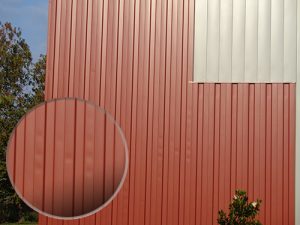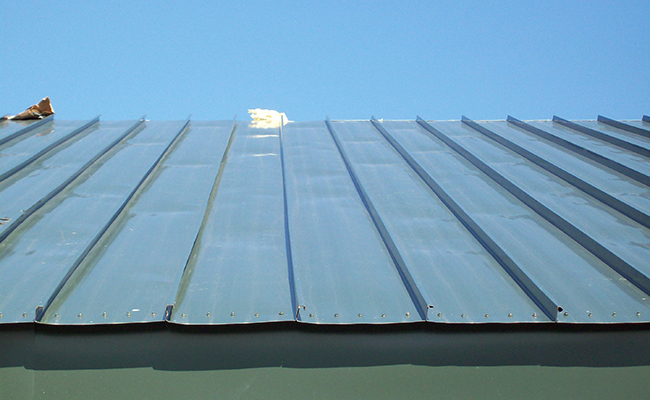Tag: oil canning
Oil Canning and Flush Metal Wall Panels
Oil canning is a broad term in the world of metal panel products and is considered one of the most vexing issues facing metal panel installations. The Metal Construction Association (MCA) defines oil canning as a “visible waviness in the flat areas of metal roof and metal wall panels.” Oil canning, also known as elastic buckling or stress wrinkling, occurs in all types of metal panels. While it is a common concern, there are steps you can take to minimize the problem.
Here, we’ll focus specifically on oil canning/distortion with metal flush wall systems, which for MBCI products includes our FW Panels and Designer Series. The type of oil canning that occurs with flush wall systems is not caused by anything dealing with the product itself or with how it’s manufactured. Rather, it is a consequence of what installers are putting the metal panels on and how the installation is done.

The simplest way to explain the phenomenon is that if the substructure is out of plane, i.e., not in alignment, stresses are put onto the panels that will create an appearance of oil canning. After all, as the old adage goes, you only get out what you put in. In the case of flush metal wall systems, the panels will look no better than what they are put on top of. If the substructure is wavy, out of plane, up or down, in or out, that condition will affect the panels’ performance and appearance.
Certain tolerances will have an effect on the panels’ appearance. With MBCI’s FW and Designer panels, tolerances would be 1/4 inch and 20 feet outward (away from two attachment points) and 0 inch and 20 feet inward. This means that if panels are forced into an inverted convex position, they will show stress rippling or oil canning more severely than when they’re stretched over a concave position, i.e., there can be some tolerance outward but zero inward.
With these types of panels, the biggest concerns with oil canning/distortion are aesthetics, but performance problems are also of concern, including possible engagement or sealing of the side joints.
Minimizing Oil Canning/Distortion of Panels
Prior to installation, installers should be checking the substructure with string lines or lasers and correcting or shimming any areas that are out of plane, especially since oftentimes substructures, such as stud walls or structural walls that the metal panels are attached to, are installed by other trades. Metal panel installers need to scrutinize each aspect for alignment and then either correct or shim to bring it within tolerance and within plane.
As is true with any metal panel product, for best results, proper handling and installation go a long way towards preventing the problem of oil canning in the field.
To find out more on how to minimize oil canning on your MBCI metal wall panels, contact your local MBCI representative, and sign up for our newsletter to subscribe to our blog.
How to Help Prevent Oil Canning
Oil canning is defined as the visible waviness in the flat portion of a metal panel. Oil canning is a visual issue, not a weatherproofing or performance issue. However, building owners will complain about waviness in metal panels on roofs, walls, and perimeter edge metal. Edge metal and metal wall panels are more of a concern than low-slope metal panels because edge metal and wall panels are visible from the ground. Steep-slope metal panels and shingles are also visible, so awareness of potential oil canning is important.
What Causes Oil Canning?
Oil canning can happen when unwanted stresses are introduced at fasteners, clips, and over purlins and uneven substrates. Over-driven fasteners, clips that are slightly misaligned relative to the clip/seam interface, and too much insulation between the purlins and panels can introduce these unwanted stresses. A misaligned panel or edge metal clip, certainly after the seam or drip edge is crimped tight, will add stresses to metal panels and edge metal
Tips to Help Prevent Oil Canning
- Place clips correctly: Setting clips in the proper location for edge metal and metal panels (roof and wall) is critical. The clip needs to fit into a panel seam without forcing the vertical seam out of plane. The clip needs to be aligned correctly and sized appropriately to not compress the vertical portion of the seam. Clips that secure edge metal need to be positioned correctly so that crimping the drip edge won’t twist or bend the edge metal.
Although not highly visible, low-slope structural panels can oil-can at clip locations and where insulation is draped over purlins. Compressed insulation at purlins can “push back,” adding stress to the panel and resulting in oil canning. - Consider the roof color: Sometimes oil canning is inevitable. The color of the metal or coating won’t really make a visual difference, but darker colors panels will heat up more in direct sunlight. This may make oil canning worse in some cases. However, striations and small ribs (which also add strength) may help prevent or hide oil canning.
- Choose a thick metal: Metal thickness matters, so specify metal that’s as thick as possible to avoid oil canning. Thicker metals are stiffer, so they may resist deformation due to unwanted stresses. This reduces the chance of oil canning in edge metal and wall panels, which are most commonly smooth-surfaced.
For more information on oil canning and its causes, see the Metal Construction Association’s white paper on the subject, which can be found at www.metalconstruction.org.
Consider these ideas on your next job.
